 |
 |
Our enthusiastic and extremely knowledgeable perennials team is here to answer your questions and help you choose the best perennials for your situation. There’s always something in bloom for sun, shade, butterflies, birds or deer resistance as well as a variety of bulbs for your space.
Stroll through our time-tested favorites and introduce yourself to the newest varieties. We garden with perennials too; we love them and it shows!
|
95 found, showing page 4 of 7
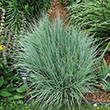
Bronze blooms. Blue-pink tinged foliage. Upright. Native. USDA 3-9
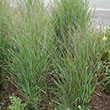
Red tipped foliage. Red blooms. Compact clumping. Native. USDA 5-9
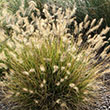
White blooms. Graceful, spreading clump. Deep green leaves. Tolerates black walnut, Dry & wet soils. USDA 5-9
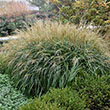
Pinkish blooms. Upright clumping grass. Self-seeding. USDA 5-9
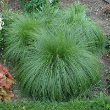
Plant Height: 24 inches
Flower Height: 3 feet
Spread: 3 feet
Sunlight: full sun, partial shade
Hardiness Zone: 2a
Description:
Native to the Great Plains and Prairies, this extremely fine-textured grass features airy plumes of fine seed heads floating over the grassy foliage in the late season; ideal for restoration projects and flowing hummocky accents in the urban landscape
Ornamental Features:
Prairie Dropseed features delicate plumes of orange flowers rising above the foliage from late summer to early fall. The tan seed heads are carried on showy plumes displayed in abundance from early to late fall. Its threadlike leaves are light green in color. As an added bonus, the foliage turns a gorgeous harvest gold in the fall.
Landscape Attributes:
Prairie Dropseed is an open herbaceous perennial grass with a shapely form and gracefully arching stems. It brings an extremely fine and delicate texture to the garden composition and should be used to full effect.
This is a relatively low maintenance plant, and is best cleaned up in early spring before it resumes active growth for the season. Deer don't particularly care for this plant and will usually leave it alone in favor of tastier treats. It has no significant negative characteristics.
Prairie Dropseed is recommended for the following landscape applications:
- Mass Planting
- General Garden Use
- Naturalizing And Woodland Gardens
Planting & Growing:
Prairie Dropseed will grow to be about 24 inches tall at maturity extending to 3 feet tall with the flowers, with a spread of 3 feet. Its foliage tends to remain dense right to the ground, not requiring facer plants in front. It grows at a medium rate, and under ideal conditions can be expected to live for approximately 10 years. As an herbaceous perennial, this plant will usually die back to the crown each winter, and will regrow from the base each spring. Be careful not to disturb the crown in late winter when it may not be readily seen!
This plant does best in full sun to partial shade. It is very adaptable to both dry and moist locations, and should do just fine under typical garden conditions. It is considered to be drought-tolerant, and thus makes an ideal choice for a low-water garden or xeriscape application. It is not particular as to soil type or pH, and is able to handle environmental salt. It is somewhat tolerant of urban pollution. This species is native to parts of North America.
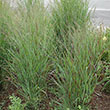
Red tipped foliage. Red blooms. Compact clumping. Native. USDA 5-9
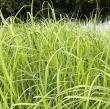
Dark green foliage turns a beautiful dark purple or near black in fall. Tolerates a wide range of soils. Good for erosion control. USDA 4-9
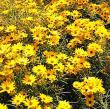
Perennial sunflower. Profuse bloomer with 2.5-3? golden yellow flowers. Tolerates clay. USDA 6-9
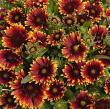
Excellent cut flower. Beaitful long bloomer from summer to fall. USDA 6-10
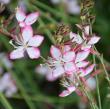
White flowers with a candy-pink picotee. Open, vase-shaped habit; tolerant of heat, humidity, and some drought once established. USDA 5-9
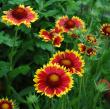
Prolific yellow-tipped red blooms. Compact. USDA 3-9
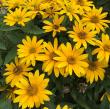
Golden yellow blooms. Compact, upright habit. Heat tolerant. Long bloomer. USDA 4-9
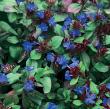
Height: 12 inches
Spread: 18 inches
Sunlight: full sun, partial shade
Hardiness Zone: 4b
Other Names: Leadwort
Description:
Excellent groundcover with clusters of the truest blue flowers in late summer; foliage turns a nice bronzy-red color in fall; flowers resemble that of woodland phlox, and the red calyces add a wonderful color contrast
Ornamental Features:
Plumbago features showy clusters of blue star-shaped flowers with brick red calyces at the ends of the stems from late summer to early fall. Its glossy oval leaves are green in color. As an added bonus, the foliage turns a gorgeous red in the fall.
Landscape Attributes:
Plumbago is an herbaceous perennial with an upright spreading habit of growth. Its medium texture blends into the garden, but can always be balanced by a couple of finer or coarser plants for an effective composition.
This is a relatively low maintenance plant, and is best cleaned up in early spring before it resumes active growth for the season. It is a good choice for attracting bees and butterflies to your yard. It has no significant negative characteristics.
Plumbago is recommended for the following landscape applications:
- Mass Planting
- Rock/Alpine Gardens
- Border Edging
- General Garden Use
- Groundcover
- Naturalizing And Woodland Gardens
- Planting & Growing
Plumbago will grow to be about 10 inches tall at maturity, with a spread of 18 inches. Its foliage tends to remain low and dense right to the ground. It grows at a medium rate, and under ideal conditions can be expected to live for approximately 8 years. As an herbaceous perennial, this plant will usually die back to the crown each winter, and will regrow from the base each spring. Be careful not to disturb the crown in late winter when it may not be readily seen!
This plant does best in full sun to partial shade. It does best in average to evenly moist conditions, but will not tolerate standing water. It is not particular as to soil type or pH. It is somewhat tolerant of urban pollution. Consider covering it with a thick layer of mulch in winter to protect it in exposed locations or colder microclimates. This species is not originally from North America. It can be propagated by division.
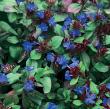
Deep blue flowers. In early fall, leaves change to a vivid mahogany red color. Growing in sun or shade. Wide range of soil types. Long-lived groundcover. USDA 5-9
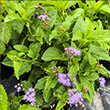
Bright blue minty leaves with purplish stems topped with masses of powder blue fuzzy flowers. Height 2-3'.
Eupatorium attracts bees and butterflies. Needs moisture if grown in full sun. Drought tolerate in shadier sites. Deer and rabbit resistant.
- USDA Hardiness Zone(s): 4-9
- Exposure: Full Sun, Part Shade
- Bloom Time(s): August-October
95 found, showing page 4 of 7







